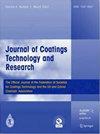Synthesis and property of room-temperature self-healable cathodic electrophoretic deposition coatings based on cationic waterborne polyurethane
Abstract
Cathodic electrophoretic deposition (CED) coatings are inevitably scratched following their application in processes such as automotive finishing. Self-healing coatings possess the ability to repair micro-scale damage, thereby extending their service life and reducing maintenance costs. Here, a novel strategy was developed to synthesize room-temperature intrinsic self-healing CED coatings by inserting 2-aminophenyl disulfide (APDS) into the polymer chain of cationic waterborne polyurethane (CWPU). Emulsion films incorporating the disulfide (SCWPU) could self-heal at room temperature via dynamic disulfide bond exchange and hydrogen bonding interactions, and their structures were confirmed by FTIR and Raman spectroscopy. The thermal properties of the SCWPU films were determined by differential scanning calorimetry and thermal gravimetric analysis. The effects of APDS incorporation and hard segment content (HSC) on the self-healing ability, mechanical and emulsion properties of the SCWPU films were systematically investigated. The results showed that the self-healing abilities of SCWPU film were 97.2% at RT over 24 h and 96.5% at 37°C (body temperature) after 4 h. CED coatings (8 μm, 3H pencil hardness) prepared from SCWPU emulsion also displayed self-healing properties at room temperature.

 求助内容:
求助内容: 应助结果提醒方式:
应助结果提醒方式:


